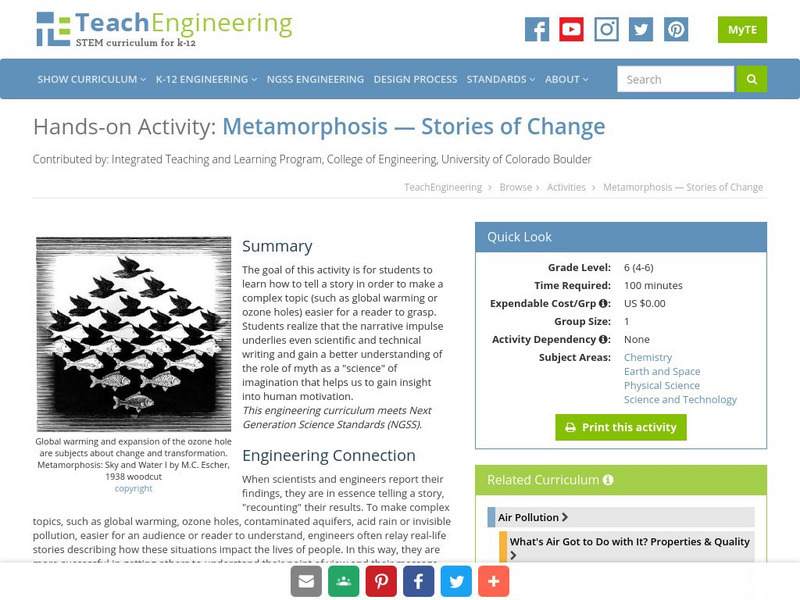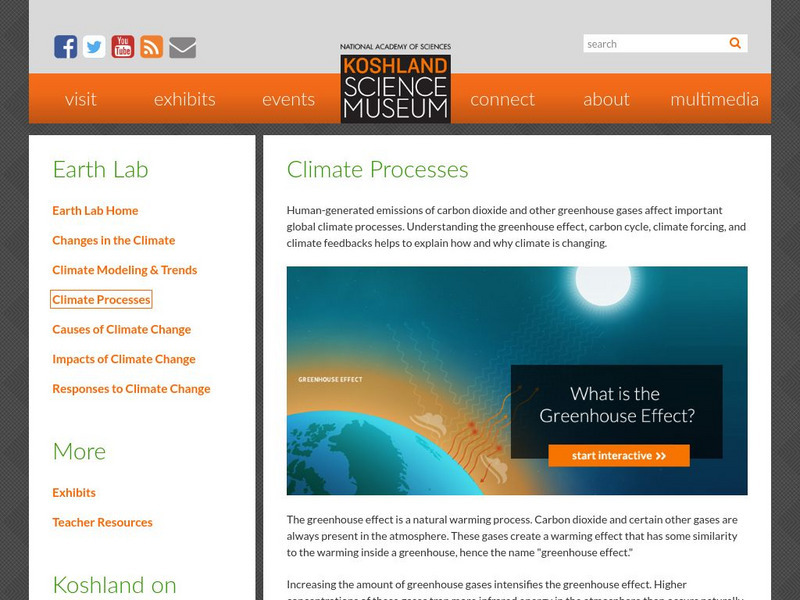Hi, what do you want to do?
Chicago Botanic Garden
Greenhouse Gas Emissions – Natural and Human Causes
Part three in the series of seven has pupils discussing the different greenhouses gases, learning about the carbon cycle, and then watching a short video about the carbon cycle. Based on their knowledge, individuals complete a greenhouse...
Curated OER
Let's Get To the Core!
Students practice analyzing ice core samples to discover climate changes. Using the samples, they identify and graph the gas amounts. They use these numbers to determine their effect on global warming. In pairs, they complete a...
Texas State Energy Conservation Office
Investigation: Waves and Whistles
Wave goodbye to the same old demonstrations for alternative energy sources, and wave hello to this one investigating ocean waves! Using a water bottle to create an oscillating water column, learners see and possibly hear how the...
National Renewable Energy Laboratory
Biomass: Biogas Generator
It's a gas. Middle schoolers build a biogas generator following the directions in this resource. After a few days of observation, they demonstrate that the gas given off by the decomposing manure is flammable. The activity concludes as...
Curated OER
Carbon Dioxide Heats It Up
Students design an investigation to test whether vegetation in an area helps regulate the ambient air temperature. They make comparisons between the investigation and global changes in climate. In groups, they present their findings to...
Curated OER
Applications of Derivatives: General Rules for Optimization
In this minima and maxima worksheet, students find the global and local maxima and minima of one function. They work in small groups to solve one optimization problem. Steps for solving are listed on the page.
Curated OER
Sunspot Graphing
Students, using 15 years of sunspot data, plot data on a classroom graph. They discuss why the pattern from their individual sheets did not and could not match the class graph.
Curated OER
Carbon Dioxide
Learners conduct a series of experiments to explore carbon dioxide properties. In this chemistry lesson plan, students explain the production and uses of this gas. They measure its amount in soda and waste product of yeast.
Curated OER
Changing Planet: Fading Corals
Show the six-minute video, "Changing Planet: Fading Corals," and then demonstrate how calcium carbonate forms a precipitate in the presence of carbon dioxide. Separate your scientists into small groups to gather information about coral...
Curated OER
Believe It...Or Not
Students critically analyze data regarding climate changes using a glossary of terms generated by examination of climate related articles. They examine and graph climatic data, and discuss, hypothesize and test apparent discrepancies in...
Curated OER
Science All Around You
Students visit and explore a Hands On Science Center (HOSC). They participate in a variety of self-guided table exercises and observe as scientists demonstrate various scientific principles.
Curated OER
Alternative Energy
Pupils discover the different alternative fuel sources. In this biology lesson, students identify the different stages of the carbon cycle. They explain the pros and cons of using alternative energy.
Curated OER
The Cream of the Crop
Young scholars read and discuss article, "Simple Method Found to Vastly Increase Crop Yields," then research the basic components of conventional and organic agricultural methods. They, in groups, organize and present their research to...
Curated OER
Breaking News English: New Machine Sucks CO2 from the Air
In this English worksheet, students read "New Machine Sucks CO2 from the Air," and then respond to 1 essay, 47 fill in the blank, 7 short answer, 20 matching, and 8 true or false questions about the selection.
Smithsonian Institution
Smithsonian Learning Lab: Prehistoric Climate Change and Why It Matters Today
Introduce students to environmental issues by studying a time of rapid global warming that occurred 50 million years ago. Lessons, video segments and interactive activities will engage students as they learn about average annual...
Smithsonian Institution
Smithsonian Learning Lab: Prehistoric Climate Change and Why It Matters Today
In a lesson in this issue of Smithsonian in Your Classroom, students do the work of a team of paleontologists studying a time of rising carbon dioxide and rapid global warming during the Eocene epoch. By examining fossils of tree leaves,...
Other
Koshland Science Museum: Earth Lab: Degrees of Change
This resource provides information on all of the aspects of global warming, climate change, and the future of the earth.
Smithsonian Institution
Smithsonian Education: Idea Labs: Prehistoric Climate Change
Sort fossil leaves from 55 million years ago into groups with smooth or 'toothed' edges. Then, use a formula to calculate the percentage of each type and, from there, look at how high the temperature might have risen when global warming...
TeachEngineering
Teach Engineering: Metamorphosis Stories of Change
The goal of this activity is for students to learn how to tell a story in order to make a complex topic (such as global warming or ozone holes) easier for a reader to grasp. Students realize that the narrative impulse underlies even...
Annenberg Foundation
Annenberg Learner: The Habitable Planet: Carbon Lab
An interactive lab simulation demonstrates the effects of increased carbon in the atmosphere and how that increase contributes to climate change. A data table for student records is available for download.
Annenberg Foundation
Annenberg Learner: The Habitable Planet: Energy Lab
Try and meet global energy demands by using alternative energy sources while keeping the carbon levels in the atmosphere down to acceptable levels. Simulator includes a data table available for download for student records.
Science Education Resource Center at Carleton College
Serc: Greenhouse Effect Lab
Students measure temperature changes inside soda bottles filled with CO2 and air as incandescent light is shined on them to model the Greenhouse Effect.
Other
Alliance to Save Energy: Educator Lesson Plans
A series of teacher lesson plans for various grade levels. Topics pertain to insulation (among other things) and other energy conservation and energy efficiency topics. Can be easily adapted for a student project or lab investigation.
Other
The Greenhouse Effect: Natural and Amplified Warming
This concise resource presents a thorough drawing which simplifies the explanation of the greenhouse effect into six easy to understand steps.

























